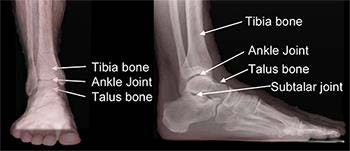Sesamoids
Sesamoids are bones that develop within a tendon. The one most people are familiar with is in the kneecap, however they most commonly occur in the foot and hand. Two sesamoids, each about the size of a corn kernel, typically are found near the underside of the big toe.
Symptoms
Pain from a sesamoid injury is focused under the big toe on the ball of the foot. With sesamoiditis or a stress fracture, pain may develop gradually, whereas with a fracture, the pain will be immediate after trauma. Swelling and bruising may or may not be present. There may be difficulty and pain when bending and straightening the big toe.
Causes
Sesamoids act like pulleys, increasing the ability of the tendons to transmit muscle forces. The sesamoids in the forefoot also assist with weight bearing and help elevate the bones of the big toe. Like other bones, sesamoids can break in a traumatic injury. They also can develop a stress fracture from overuse. In addition, the tendons surrounding the sesamoids can become irritated or inflamed. This is called sesamoiditis and is a form of tendinitis or tendinosis. It is common among ballet dancers, runners, and professional athletes.
Diagnosis
During your examination, your foot and ankle orthopedic surgeon will look for tenderness at the sesamoid bones. Your doctor may manipulate the bone slightly or ask you to bend and straighten the toe. He or she also may bend the big toe up toward the top of the foot to see if the pain intensifies.
Your surgeon will request X-rays of the forefoot to ensure a proper diagnosis. In many people, the sesamoid bone nearer the center of the foot (the medial sesamoid) has two parts (bipartite). Because the edges of a bipartite medial sesamoid are generally smooth, and the edges of a fractured sesamoid are generally jagged, an X-ray is useful in making an appropriate diagnosis. Your physician also may request X-rays of the other foot to compare the bone structure. If the X-rays appear normal, the physician may suggest additional tests such as an MRI or CT scan.
Treatment
Treatment for sesamoiditis usually is nonoperative and successful, but can be frustrating in how long it takes for symptoms to resolve. If conservative measures fail, your physician may recommend surgery to remove the sesamoid bone. First, your specialist will recommend the following:
- Stop the activity that causes the pain.
- Take acetaminophen or ibuprofen to relieve the pain.
- Rest and ice the sole of your foot. Do not apply ice directly to the skin; use an ice pack or wrap the ice in a towel.
- Wear soft-soled, low-heeled shoes.
- Use a felt cushioning pad around the sesamoid to relieve stress.
- Return to activity gradually and continue to wear a cushioning pad of dense foam rubber under the sesamoids to support them. Avoid activities that put your weight on the balls of the feet.
- Tape the big toe so that it remains bent slightly downward.
In rare occasions, a steroid injection may be appropriate.
If symptoms persist, you may need to wear a removable boot or a cast for 4-6 weeks. Sesamoids tend to heal slowly.
If you have fractured a sesamoid bone, your foot and ankle orthopedic surgeon may recommend conservative treatments before resorting to surgery. You will need to wear a stiff-soled shoe, a boot, or possibly a cast, and your physician may tape the joint to limit movement of the big toe. You also may have to wear a J-shaped pad around the area of the sesamoid to relieve pressure as the fracture heals. Pain relievers such as acetaminophen or ibuprofen may be recommended as well, but know that it may take several months for the discomfort to subside.
In some cases, a fractured sesamoid requires surgery. In this case, repair sometimes can be performed, but often removal of part or all of the sesamoid will be needed.
Recovery
Healing of the sesamoid typically is slow and can take up to six months. The process can be frustrating but is usually successful.
Risks
Failure of healing, avascular necrosis, development of arthritis at the joint between the sesamoid and the first metatarsal, and continued pain are the risks associated with sesamoid injuries. If these should develop, excision of part or all of the sesamoid can usually resolve symptoms.

